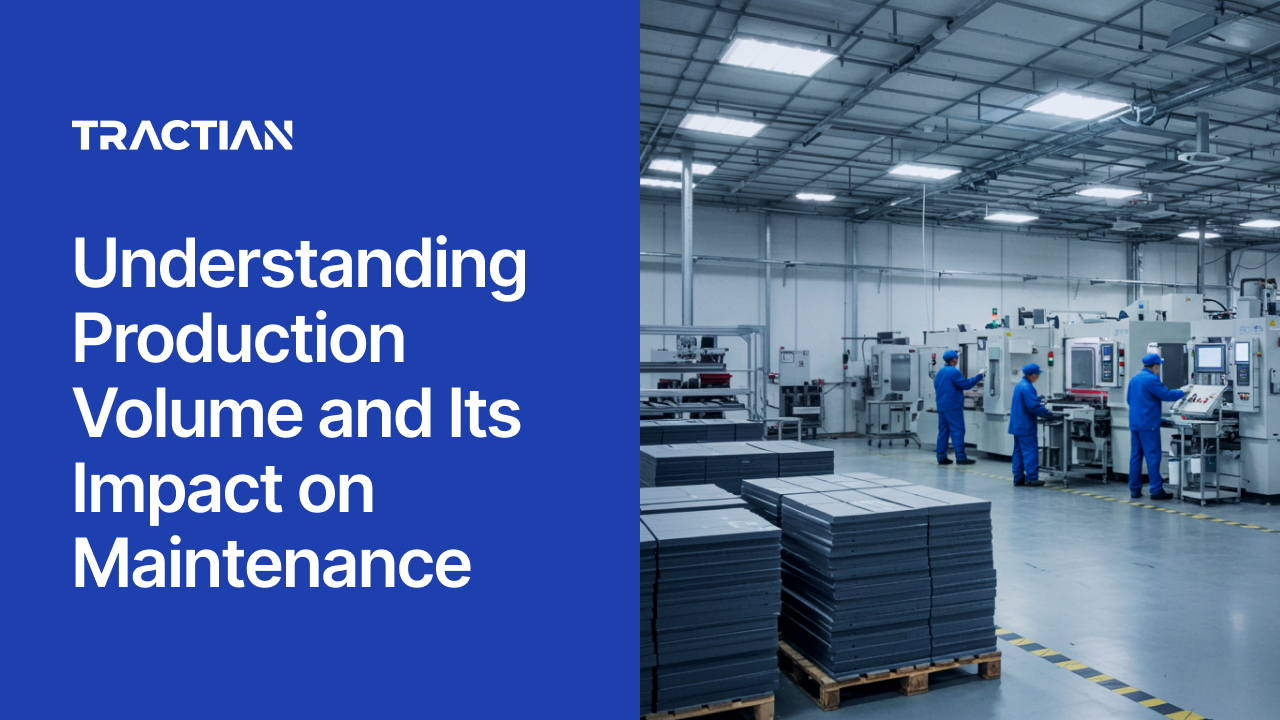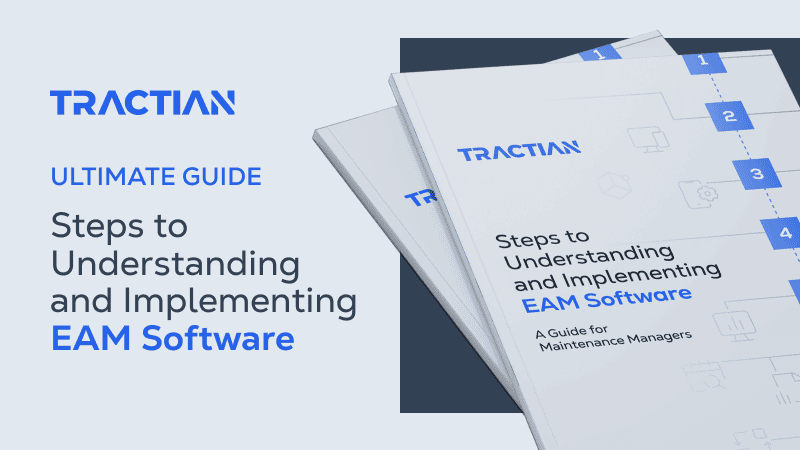When your production line hits its stride, everything feels perfectly synchronized. Equipment hums along, output flows steadily, and your team operates with the confidence that comes from predictability. But when production volume starts fluctuating unexpectedly, that harmony quickly and dramatically falls apart.
Production volume is the heartbeat of your operation. It’s intimately connected to equipment health, maintenance timing, and your bottom line. Understanding how to measure, track, and optimize production volume while maintaining equipment reliability is what distinguishes operations that thrive from those that constantly struggle.
This guide will show you how to calculate production volume and variance, align your maintenance strategy with volume targets, and use real-time data to make decisions that protect both productivity and equipment longevity.
What Is Production Volume?
Production volume represents the total quantity of goods or services your facility produces within a specific timeframe. Whether you're measuring pieces per hour, tons per day, or batches per month depends entirely on what your operation produces.
For maintenance teams, production volume directly influences how hard equipment works and how frequently it needs attention. Operations managers track it to measure efficiency and plan capacity. Yet, maintenance professionals use it to schedule preventive work and predict when assets will need service.
Several key components determine your production volume. Equipment capacity sets the upper limit, operating time defines availability, efficiency rates show how well you're using that capacity, and downtime events reveal what's stealing your production potential.
Most facilities measure production volume in units per hour, shift, or day. Process industries might track tons per hour or gallons per minute, while discrete manufacturers typically count pieces or assemblies coming off the line.
How to Calculate Production Volume and Variance
The basic production volume calculation multiplies the number of units produced by the time period you're measuring. To determine your daily production volume, multiply the number of units your line produces per hour by the total number of hours it operates each day.
Production Volume Formula: Units per hour x Hours of operation = Daily production volume
This baseline helps you compare performance across shifts, days, or months. But the real insight comes from understanding variance, which reveals the difference between what you planned to produce and what actually happened.
Production Volume Variance Formula
Production volume variance measures the gap between your budgeted production and actual production, expressed in financial terms. It shows whether you're meeting production targets and how deviations affect your bottom line.
When it falls short, the variance is unfavorable, often caused by equipment downtime, quality issues, or maintenance delays that reduce throughput.
Example Volume Calculation
Consider a packaging line with a daily production target and a standard fixed overhead rate applied to each unit produced. If the actual production is less than the budgeted amount, your calculation would reflect that difference as follows:
- A budgeted production target is established for the line each day.
- Actual units fell short of the budgeted target.
- Variance is calculated by multiplying the difference between actual and budgeted units by the standard fixed overhead rate. A negative result indicates an unfavorable variance.
Production Variance Formula: (Actual units - Budgeted units) x Standard fixed overhead rate
An unfavorable variance like this often suggests that issues such as equipment problems or unplanned maintenance may have impacted the line’s ability to meet its production target.
High Volume Production vs Low-Volume Manufacturing
The volume your facility produces shapes everything from equipment selection to maintenance strategy. High-volume production prioritizes speed and consistency, while low-volume manufacturing focuses on flexibility and precision.
The method of producing large quantities of goods efficiently requires robust preventive maintenance programs and real-time monitoring to catch problems before they cause shutdowns.
Production Value vs Production Volume
Production volume counts quantities while production value measures the monetary worth of what you produce. A facility might increase production volume by 20% but see production value drop if they're making lower-priced products or dealing with quality issues.
Here's how these metrics differ in practice. Production volume focuses on quantity-based measurement, tracking units, pieces, or batches produced within a timeframe. Production value represents the financial measurement of total monetary worth, calculated by multiplying volume by unit price.
Understanding both metrics helps maintenance teams prioritize their work. High-value, low-volume products might justify more intensive maintenance than high-volume, low-value items. Production value meaning extends beyond simple counting to encompass the economic impact of what your equipment produces.
Essential Production Metrics for Reliability
Tracking the right metrics connects production performance to the effectiveness of maintenance. When you know which numbers matter, you can spot problems early and make data-driven decisions about asset care.
Volume Metrics That Matter
Actual production tells you what your equipment delivered, but total volume over time reveals trends and patterns that can help you optimize your operations. Volume time, or the time it takes to produce a specific quantity, indicates efficiency changes that may signal developing maintenance needs.
Track daily, weekly, and monthly production volumes to identify patterns. Sudden drops often indicate equipment issues, while gradual declines may suggest wear that requires attention.
Manufacturing Variance Analysis
Manufacturing variance breaks down the difference between planned and actual production into specific categories. Material variance shows if you're using more raw materials than expected, while labor variance indicates efficiency changes that could stem from equipment problems.
The variance of product quality also affects volume. When defect rates rise, the effective production volume falls, even if total output remains constant. This connection makes quality metrics essential for understanding true production capacity.
Volume-Based Business Decisions
Production-volume data drives decisions about maintenance timing, resource allocation, and capital investments. Volume-based business planning uses historical production patterns to predict future maintenance needs and budget requirements.
When volume consistently exceeds capacity, it signals the need for additional equipment or more intensive maintenance to prevent breakdowns. Conversely, declining volumes might indicate market changes or equipment degradation that requires investigation.
How Production Volume Impacts Maintenance Strategy
Higher production volumes create more wear, generate more heat, and stress equipment components beyond their design limits. A conveyor running 24/7 needs different maintenance than one operating 8 hours daily, even if they're identical models.
Equipment in these environments often runs intermittently, creating different failure modes like seal drying, bearing corrosion due to inactivity, and thermal cycling stress.
High-volume operations involve continuous production, which accelerates wear patterns, increases lubrication needs, and necessitates more frequent inspections to identify problems before they cause expensive failures.
Seasonal fluctuations add another layer of complexity. Many operations see volume swings throughout the year, requiring flexible maintenance strategies that can adapt to changing production demands without compromising reliability.
The relationship between volume and maintenance isn't linear. Doubling production volume might triple maintenance requirements due to accelerated wear and reduced maintenance windows.
Aligning Maintenance Schedules with Production Goals
Smart maintenance planning balances equipment needs with production targets.
Planning Maintenance Around Volume Metrics
Use historical volume patterns to identify periods of low production, which can make major maintenance work easier to undertake. The budget production formula should include maintenance costs that scale with volume, as higher production means more frequent service intervals and increased parts consumption.
Schedule routine maintenance during planned production breaks, but don't defer critical work just to hit volume targets. A small production loss today prevents a major breakdown tomorrow.
Coordinating Production and Maintenance Budgets
Maintenance and production budgets must work together, not compete. Overhead variance is calculated as the difference between budgeted and actual overhead costs, and maintenance represents a significant portion of manufacturing overhead.
As production volume increases, maintenance costs typically rise in proportion. Budget for this relationship rather than treating maintenance as a fixed cost that doesn't change with production levels.
Real-World Production Volume Optimization
INPASA, a major agribusiness operation, transformed their production reliability by implementing systematic maintenance practices that directly supported volume targets. Their maintenance director, Itiel Cerkunvis, noted the partnership approach: "TRACTIAN isn't simply a sensor provider, TRACTIAN is a business partner who provides availability to our operations."
The company faced challenges with unpredictable equipment failures that disrupted production schedules and created costly volume variances. Traditional reactive maintenance couldn't keep pace with their high-volume processing demands.
By implementing condition monitoring and predictive maintenance strategies, INPASA achieved remarkable improvements in equipment reliability. The systematic approach eliminated surprise breakdowns and enabled consistent production volume that met business targets while helping to lower overall maintenance costs.
Maximizing Operational Efficiency Through Volume Management
Maintaining optimal production volume requires systematic tracking, proactive maintenance, and real-time visibility into equipment performance. Modern CMMS solutions provide the data integration and analysis tools needed to balance production targets with equipment reliability.
The key is connecting volume metrics to maintenance actions. When production drops, you need to know whether it's due to market demand, equipment issues, or maintenance needs. This visibility enables quick responses that protect both equipment and production goals.
Successful volume management treats maintenance as an enabler of production, not a constraint. When maintenance teams have access to real-time production data and can plan their work around volume targets, both reliability and productivity improve.
How Tractian's CMMS Can Transform Your Production Volume Management
Achieving real value from production volume data requires having the right systems in place to capture, analyze, and act on that information. The best CMMS platforms connect production metrics directly to maintenance decisions, creating a feedback loop that drives continuous improvement.
Yet, most operations struggle with their current systems, treating production and maintenance as separate functions. Production data sits in one system, maintenance records in another, and connecting the dots requires manual effort that rarely happens consistently.
Tractian's CMMS was designed to bridge this gap from day one. Production volume metrics integrate seamlessly with maintenance schedules, work orders, and asset performance data. When volume drops, the system automatically flags potential equipment issues and suggests maintenance actions based on historical patterns.
Our platform takes volume-based maintenance planning beyond simple scheduling. With AI-powered insights and real-time production monitoring, you can predict when equipment stress will require attention, schedule maintenance during optimal production windows, and track the direct impact of maintenance decisions on volume targets.
All of this comes with rapid deployment and intuitive interfaces that your team can start using immediately. No complex integrations or months of training required. Just clear visibility into how your maintenance actions directly support production goals.



